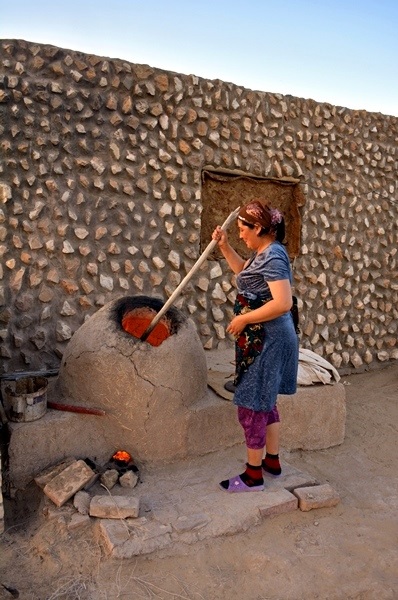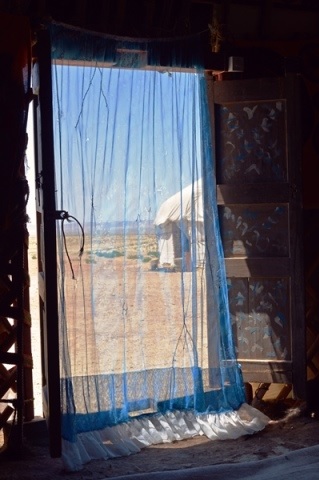
The camp was perched on a mesa next to the ruins of an ancient fortress called Ayaz Kala that was inhabited between the 4th Century BCE and the 7th Century ACE. In its heyday, Ayaz Kala stood guard over an oasis and a fertile farming plain that existed in the first millennium BCE. It also provided refuge for the inhabitants when the countryside was under attack by invaders. Today, the seemingly endless Kyzylkum Desert lies below the fortress, with its shifting sand, scrub vegetation and dried salt lakes. Even with the unusually wet rainy season that just passed, the Kyzylkum is a hot, dry and foreboding place.
When I arrived, I was welcomed by the enthusiastic matriarch of the family. It was afternoon and blazingly hot in the desert, with no shelter except for the yurt – so I hunkered down for a nap to await the cooler weather that comes with the setting of the sun. Inside the yurt was indeed dark, but it was a lot less hot than outside. As I drifted off to sleep, I gazed at the beautiful woven and printed fabrics that hung from the roof or were draped around the yurt shutting out the harsh climate and decorating the inside all at the same time.
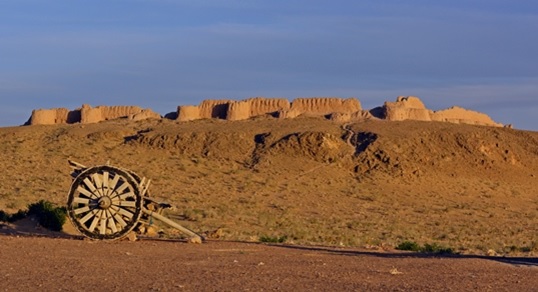
Some of the designs on the woven yurt straps had clear Scythian roots, while the printed fabrics were still geometrics, but were more modern looking. I fell asleep with visions of Scythian warriors, roaming the steppes on horseback, and hordes of their hidden gold filling my head.
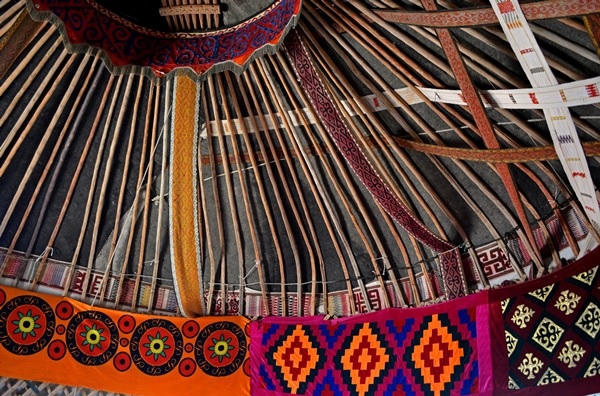
When I woke up I could already smell the wood fires burning, someone was beginning to prepare dinner. I headed out to find the cook. I found a pair of women, sisters-in-law, getting ready to make bread. The older woman was stirring and stoking the tandyr oven to warm it up, and the younger woman, putting the finishing touches on the form and size of the bread and getting ready to stamp designs on it with a checkish bread stamp.
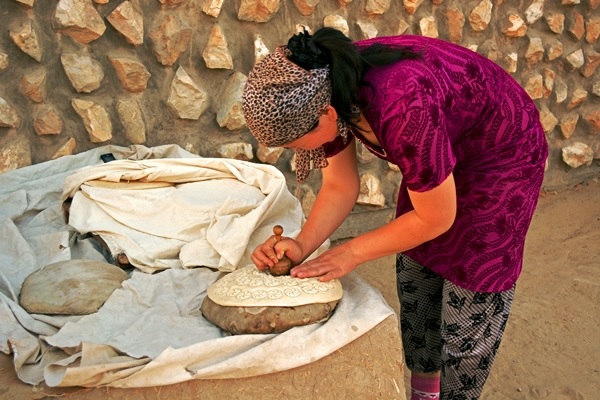
Now, most people in Uzbekistan, regardless of their ethnicity, use two different types of tandyr oven. One that is vertical for samsas – small meat-or-potato-stuffed pastries, and one that is tilted as you can see in the photograph, for the ubiquitous Asian flatbread, called “non” or “naan”.
The sisters-in-law were laughing and joking and generally having a good time and allowed me to join in. We all had enough Russian to communicate, so it worked out fine.
They allowed me to help with the tandyr, which I must say is a hot job. It was probably still in low 90s or high 80s F, and standing in front of the oven and feeding the fire is tough, with the flames sometimes blazing up outside the mouth of the stove. When the fire was ready, the older of the pair covered the hole you see in the oven on the bottom left with stones, to help the fire settle and keep the heat inside. When the oven was ready, the older of the pair excused herself to go get something.
The younger sister-in-law started to stamp the bread with the checkish using very quick strokes so that the bread didn’t stick to the tines of the tool. When she was done with each bread, she simply started to pile them on top of some bread forms she had. She allowed me to try my hand at a few breads with the checkish and having watched her carefully, I did just fine. The designs were in good form and no sticky mistakes, and ready for the oven.
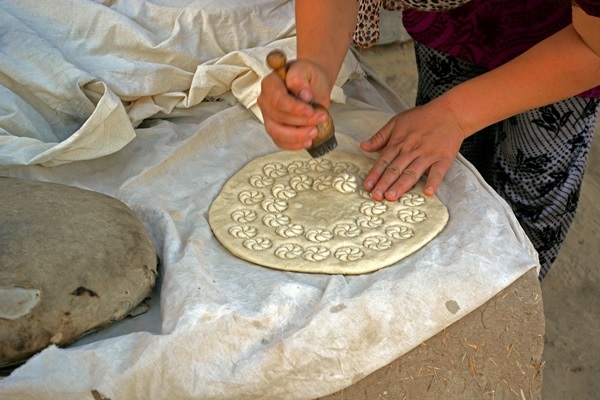
The older sister-in law reappeared with a sweater and a heavy jacket on and a re-wrapped headscarf that also covered her lower face – looking something like a wild bandit. She placed oven mitts on her hands and was ready to bake some bread. One by one, she took up the breads that we had stamped and sprinkled water on them to help them adhere to the side of the oven. One-by-one, she slapped them – by hand – on the side of the oven. No tools were used, just protected hands. SLAP, another bread in the oven, SLAP another, and so on.
What surprised me most about the process was that, 1.) she didn’t turn the bread, and 2.) total baking time didn’t exceed 4-5 minutes, maybe less.
When the bread was done, she grabbed it with, again with her hands, and tossed it on a bread mold to cool. They offered me a piece of bread when it was just a minute or two out of the oven and it was hot and slightly crisp on the outside, but soft and airy on the inside. In other words, it was perfect. Our evening meal was simple but delicious. A salad of tomatoes and cucumbers, plov and of course “non”.
After dinner, a went out to one of the areas laid with carpets on the edge of the mesa to watch the sun set and the stars emerge from the firmament. One by one they came . . . so many stars. I laid down just to get a better look at the sky and heard a strange vibrating sound from a distance. In all honesty, I thought it was someone’s ring tone when I first heard it, but it kept on going.
I went into the main tent to find a man playing what I would have called a, “Jews Harp”. He held the main part of the instrument between his teeth and in large, gorgeously graceful strokes, caressed the tongue of the instrument to produce its characteristic twang. It was magical to hear out there in the middle of the desert.
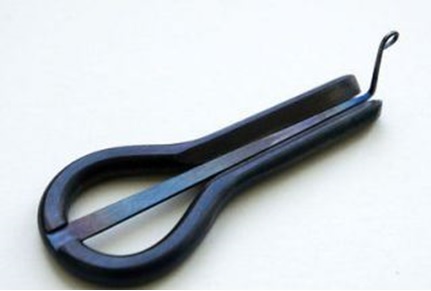
What I learned that night is that the, “Jews Harp” is actually a traditional musical instrument in the Khorezem area of Uzbekistan where we were. The player hypothesized that perhaps, the term, “Jews Harp”, and been confused with the more descriptive term, “Jaws Harp”. Another Silk Road legacy reclaimed.
I stopped to look at the stars again before making my yurt – so many stars – and could still hear the sound of the jaws-harp as I drifted off to rest. (All Words and Photos by Laura Kelley.)

